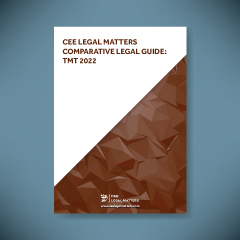Contributed by Nestor Nestor Diculescu Kingston Petersen.
1. Legal framework for writing and electronic contracts
a. What are the requirements in your jurisdiction to consider a document to be in writing? Are there any formal/technical requirements?
In a broad sense, a document in writing (Tr. inscris) is any writing or other record that includes data about a legal act or fact, regardless of its form or the method of preservation and storage.
However, when the law specifically requires the written form of a legal act (e.g., the written form of a contract), for ad probationem or ad validitatem purposes, the legal act is considered to be in writing when it is under private signature or in authentic form (e.g., signed before a public notary).
The legal act under private signature is the one that bears the signature of a person, regardless of its form. Normally, it is not subject to a specific formality, apart from some exceptions expressly provided by law.
b. Are electronic documents [e.g., an email] per se considered to be in writing under your law?
The legal effects of electronic documents (Tr. inscris in forma electronica) are recognized by law, but not any electronic document has per se the same probative power as a document under a private signature.
Depending on the form of the electronic document (e.g., if it is signed by a person or the type of electronic signature associated with it), the electronic document may have the power of a document under private signature or be considered merely as incipient written evidence, which is not in itself sufficient for proving a legal act and needs to be supplemented by other evidence in case of legal proceedings (see Sections 1.c. and 1.d.).
c. What probative power paper and/or electronic documents have that are to be considered in writing?
The signature of a document (regardless of its form, e.g., paper or electronic form) attests, until proven otherwise, the existence of the consent of the person who signed it regarding its content. If the signature belongs to a public official, it gives authenticity to that document.
The written document under private signature, recognized by the one against whom it is invoked, or considered by law as recognized, as the case may be, serves as evidence between the parties until proven otherwise. The mentions in the written document under private signature that are directly linked to the legal relationship of the parties are also proof in the absence of any evidence to the contrary.
Particularly for electronic documents, Law No. 455/2001 on electronic signatures (Law No. 455/2001) provides that a document in electronic form is assimilated, as far as its conditions and effects are concerned, to a document under private signature, if an extended electronic signature has been incorporated, attached to or logically associated with it, based on a qualified certificate not suspended or revoked at the relevant time, and generated with the help of a secure electronic signature creation device (QES).
[QES is the equivalent of the “qualified electronic signature” defined by EU Regulation No. 910/2014 on electronic identification and trust services for electronic transactions in the internal market and repealing Directive 1999/93/EC (eIDAS Regulation)].
Nevertheless, besides the above general rule laid down by Law No. 455/2001, there are special legal provisions applicable in specific domains (e.g., employment, relation with some public institutions) which assimilate the legal effect of the documents signed with an extended electronic signature (AdES) to that of documents under private signature.
[AdES is the equivalent of the “advanced electronic signature” defined by the eIDAS Regulation].
d. What are the general rules and requirements to conclude a contract electronically?
As a principle, most contracts can be concluded either in writing or verbally and still be binding upon the parties thereto. However, there are certain contracts that must have a written form in order to be considered as validly concluded (ad validitatem) or to be able to be proven in case of legal proceedings (ad probationem). Failure to observe the ad validitatem formality renders the respective legal operation invalid. While failure to observe the ad probationem formality will not affect the validity of the parties’ agreement or the legal operation in itself, it will however make it impossible to produce evidence with respect to such contract in case of court proceedings.
If the written form of a contract is required by law in order to be able to prove the existence of the document or as a validity condition, concluding such a contract in an electronic form will be considered to satisfy the aforementioned requirement only if the contract has a QES attached. However, there are special legal provisions (e.g., regarding employment relationships) that derogate from the general rule and specifically recognize the signature of a document using an AdES, even when such documents should be concluded in writing.
When contracts are concluded by electronic means, the signature of the parties is valid if it is reproduced under the technical conditions provided by Law No. 455/2001.
The QES is presumed by Law No. 455/2001 as meeting the technical conditions required by law (laid down by Article 4 item 4 of Law No. 455/2001 and which are quite similar to the ones laid down by Article 26 of eIDAS Regulation). The party which does not recognize a QES must prove in Court that the technical conditions of Article 26 of eIDAS Regulation / Article 4 item 4 of Law No. 455/2001 have not been met.
By contrast, AdES is not presumed to meet the technical conditions provided by Article 26 of the eIDAS Regulation / Article 4 item 4 of Law No. 455/2001, and the party invoking an AdES before the Court must prove that the AdES complies with the technical conditions.
Finally, we note that electronic signatures produce their legal effects only when they are attached to a document in electronic form. Once an electronic document is signed with an electronic signature (either QES or AdES), it cannot be printed and signed by the other party using a handwritten signature.
e. Are there any sector-specific rules that define further requirements to conclude contracts electronically [e.g., contracting via an authenticated electronic channel, contracting via video chat, etc.]?
As mentioned before, if the written form of a contract is required by law for ad validitatem purposes (e.g., surety, mortgage, donation, mandate in certain cases) or ad probationem (e.g., transaction, deposit, legal assistance, insurance, commission, mandate in certain cases, lease for becoming executory title), the electronic contracts must be signed using a QES. Exceptions, when the AdES is recognized as having the same power as documents under private signature, are expressly provided by law.
For instance, from an employment law perspective, according to the most recent legal developments, the use of either AdES or QES has been officially recognized in employment relations for the conclusion, amendment, and termination of individual employment agreements, as well as for addenda and annexes thereof.
From the perspective of the relationship with public authorities and institutions, according to Government Emergency Ordinance No. 38/2020 on the use of electronic documents at the level of public authorities and institutions (GEO No. 38/2020), public authorities and institutions have the obligation (a) to receive documents signed with electronic signature and (b) to determine the type of electronic signature to be used for the service provided by those authorities which are available online.
The documents signed with an AdES, which are transmitted using substantial or high-level authentication mechanisms, are assimilated, in terms of their conditions and effects, to the documents signed under private signature. Consequently, in case of legal proceedings, the documents bearing an AdES, provided it is accepted by the respective public institution, will be considered evidence between the parties until proven otherwise.
2. Digital signatures
a. Are there any laws regulating the use of digital signatures in your jurisdiction?
Yes, assuming that by digital signature it is meant an electronic signature.
The main normative acts regulating electronic signatures are:
(a) Law No. 455/2001 regarding electronic signature together with the Technical and Methodological Norms of 2001 for the application of Law No. 455/2001 regarding the electronic signature; and
(b) EU Regulation no. 910/2014 on electronic identification and trust services for electronic transactions in the internal market and repealing Directive 1999/93/EC.
b. Is there any difference between the different types of digital signatures in your jurisdiction?
Yes, there are three types of electronic signatures recognized by eIDAS Regulation and by Law No. 455/2011. We note that Law No. 455/2011 is not fully aligned with the provisions of the eIDAS Regulation, and some definitions provided by Law No. 455/2001 may slightly differ from the ones provided by the eIDAS Regulation, without affecting however the essence of such definitions. Whereas the eIDAS Regulation is of direct applicability, we refer below to the definitions provided therein:
- (Simple) electronic signature (SES) is defined as data in an electronic form that is attached to or logically associated with other electronic data, and which is used by the signatory to sign.
An email signature or the signature given on certain signature pads has been qualified as a SES by certain authors.
- AdES is defined as an electronic signature that meets the following requirements: (i) it is uniquely linked to the signatory; (ii) it is capable of identifying the signatory; (iii) it is created using electronic signature creation data that the signatory can, with a high level of confidence, use under his sole control; and (iv) it is linked to the data signed therewith in such a way that any subsequent change in the data is detectable.
Law No. 455/2001 refers to AdES as an ”extended electronic signature.”
- QES is defined as the extended electronic signature that is created by a qualified electronic signature creation device and which is based on a qualified certificate for electronic signatures.
Law No. 455/2001 refers to QES as an ”extended electronic signature based on a qualified certificate.”
c. What probative power each type of digital signature has in your country?
The legal effects and admissibility as evidence of the electronic signature differ between QES, on the one hand, and SES/AdES, on the other hand.
As regards QES, the eIDAS Regulation provides that its legal effect is equivalent to the legal effect of a handwritten signature, while Law No. 455/2001 provides that an electronic document that bears a QES is assimilated, in what concerns the conditions and its legal effects, to the document under private signature.
As regards AdES, the eIDAS Regulation does not define its legal effects, but grants a considerable leeway to EU member states in this respect, subject to the condition that EU Member States do not deny the legal effects of an electronic signature, or admissibility as evidence in legal proceedings solely on the grounds that it is in an electronic form or that it does not meet the requirements for QES.
At the national level, contrary to the case of QES, Law No. 455/2001 does not recognize ab initio the documents signed with an AdES as a document signed under private signature, but admits its legal effects and accepts its admissibility as evidence in court, as follows:
- When the AdSE is not recognized by the party against whom it is invoked, the electronic document is to be regarded, in our opinion, as “incipient written evidence” (Romanian “inceput de dovada scrisa).
Within the meaning of the Romanian Civil Procedure Code, any written document (Tr. inscris), even unsigned and undated, that comes from a person against whom that written document is opposed to/presented or from the one whose successor in rights that person is, is considered an “incipient written evidence,” if the writing makes the claimed fact credible. Incipient written evidence is not in itself sufficient for proving a legal act and needs to be supplemented by other evidence in case of legal proceedings (e.g., additional documents/correspondence, presumptions).
- When the AdSE is recognized by the party against whom it is invoked, the electronic document is considered to have, between the parties thereto, the same legal effect as for an authentic document (i.e., it provides full proof that it was signed under a private signature).
If one of the parties does not recognize the electronic document or the signature (regardless of the type of signature), the court must always order that the verification be done by specialized technical expertise. For this purpose, the expert or specialist must request qualified certificates, as well as any other documents necessary to identify the author of the document, the signatory, or the holder of the certificate.
The burden of proof differs between QES and AdSE. QES is presumed by Law No. 455/2001 as meeting the conditions provided by Article 26 of eIDAS Regulation / Article 4 item 4 of Law no. 455/2001, and therefore, the electronic documents bearing a QES will be considered evidence between the parties until proven otherwise. By contrast, AdES is not presumed to meet the above conditions, the party invoking the AdES before the court having the burden to prove AdES’s compliance with such technical conditions.
d. Are there any specific groups of people that are required to have digital signatures [e.g., attorneys, notaries, government officials, etc.]?
The interaction with certain public authorities or institutions requires the mandatory use of electronic signatures. For instance, taxpayers (e.g., companies, associations, or other professionals) can interact with the fiscal authorities only by electronic means and are required to submit fiscal documents using an electronic signature.
e. Are non-personalized digital stamps recognized in your country with probative power [e.g., digital stamps used by companies, government, or administrative bodies]?
[We assume that by digital stamp it is understood electronic seal, as regulated by the eIDAS Regulation: “data in electronic form, which is attached to or logically associated with other data in an electronic form to ensure the latter’s origin and integrity.”]
Romanian law recognizes the legal effects of the electronic seals, their admissibility as evidence being similar to the one provided for the electronic signature. The qualified electronic seal guarantees the authenticity and integrity of a document issued by a legal person.
As laid down in the recitals to the eIDAS Regulation, when a transaction requires a qualified electronic seal from a legal person, a qualified electronic signature from the authorized representative of the legal person should be equally acceptable.
If the “non-personalized” electronic seal does not ensure certainty of the document’s origin and integrity, it cannot serve as evidence that the electronic document was issued by the respective legal person.
3. Digital archiving
a. Are there any laws regulating digital archives and digital archiving in your jurisdiction?
Yes, as follows:
- Law No. 135/2007 on archiving documents in electronic form (Electronic Archiving Law) establishes the legal regime applicable to the creation, preservation, consultation, and use of documents in electronic form archived or to be archived in an electronic archive.
- Order No. 493/2009 on the technical and methodological norms for the application of Law No. 135/2007 on archiving documents in electronic form (Order No. 493/2009) lays down the procedure for granting, suspending, or withdrawing the accreditation of an electronic archive, as well as the conditions for carrying out this activity.
- Order No. 489/2009 on the methodological norms for the authorization of data centers lays down the procedure and conditions for granting, suspending, and withdrawing data centers’ authorizations, as well as the content, period of validity, and effects of the suspension or withdrawal of the authorizations.
- Law No. 16/1996 on the National Archives (National Archives Law) and the supplementary legislation that provides rules shall also be observed when archiving documents in an electronic form.
b. What are the main legal and technical requirements to digitally archive documents?
According to the Electronic Archiving Law, any natural or legal person has the right to submit documents in electronic form for archiving within an electronic archive, under the conditions of the law.
The Electronic Archiving Law provides that the receipt of a document in electronic form in the electronic archive is subject to the fulfillment of the following requirements:
- the person who holds the right to dispose of the document in electronic form (Holder) must sign the document with a QES [we note a discrepancy between the Electronic Archiving Law which refers to an “extended electronic signature” and Order No. 493/2009 which refers to QES; in practice, the competent authority (i.e., the Romanian Digitization Authority) considers that a QES must be attached]
- the QES used by the Holder should be within its validity term
- if the case, the encrypted document falling within the scope of the National Archives Law should be submitted together with the encryption and decryption key
- the document should be submitted together with a set of minimum information expressly required under the Electronic Archiving Law.
The document in electronic form which meets the conditions laid down by the legislation shall be signed electronically by the electronic archive manager, with an electronic signature, which shall also certify that the document in question is an original or a copy, as determined by the Holder. The document in an electronic form identified as such shall be archived in the location determined by the electronic archive manager.
The electronic archive manager shall register and keep a record of all the documents submitted to the electronic archive, by keeping an electronic registry. Once registered, the content of the document cannot be modified. The electronic archive manager shall fill in an electronic file for each document, including details on the conditions of access to the document, as established by the Holder, which will be archived separately from the document.
The electronic archive manager has additional obligations, such as keeping the electronic archive in good condition, observing certain safety rules, ensuring the integrity, security, and confidentiality of the archived documents, keeping the source code of all programs used for the creation and operation of the electronic archive and submitting to the National Archives a copy of such source code, ensuring the destruction of any document upon the expiry of the archiving period, and ensuring financial resources to cover the damages that could be caused during the electronic archiving activities.
The applicable legislation provides additional requirements in respect of archiving documents in electronic form, for instance, as regards the accreditation of the electronic archive manager, the preservation and consultation of the electronic archive, and the data centers that store the electronic archives.
In respect of data centers that store electronic archives, such are subject to prior authorization by the competent authority. To receive such an authorization, the data center must prove it complies with a series of technical criteria that ensure: (i) the integrity and security of the electronic documents; (ii) the security and integrity of the space where the equipment storing the electronic archive is located; and (iii) the retrieval of information in case of natural disaster, according to the law.
c. Is there any difference in your country’s regulations between the digital archiving of paper and electronic documents?
There is a requirement that if the document in electronic form was generated by transferring the information from analog to digital media (i.e., scanned copy of the original paper), the following additional information will also be necessary for including the document in the electronic archives: references to the owner of the original, the location of the original, the transfer method used, and the hardware device and the computer program used.
d. Is any third party required to participate in the process of digital archiving in your country [e.g., a trusted service provider, government / administrative bodies, etc.]?
Yes, for instance:
- a Holder could use the services of a third-party entity acting as an electronic archive manager, in which context that entity would have several obligations as regards the archiving of documents in electronic form.
- the legislation provides several obligations that require the participation of the competent authority (i.e., the Romanian Digitization Authority) and of the National Archives.
We emphasize that the legislation sets forth obligations in relation to the (former) Ministry of Communication and Information Society as the competent authority. However, considering that the Romanian Digitization Authority has taken over the responsibilities of the (former) Ministry of Communication and Information Society, the obligations would now be interpreted as being in relation to the Romanian Digitization Authority.
e. Are there any sector-specific requirements and rules for digital archiving [e.g., archiving both the software and the related data to retrieve information in the financial sector]?
There could be some sector-specific requirements, for instance, in respect of classified documents, in which context an in-depth analysis of the requirements applicable in various sectors should be done.






